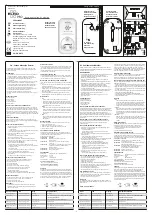
Intelligent Products—2551J and 2551TJ Plug-In Intelligent Photoelectronic Smoke Detector 11
Testing and Maintenance
Procedures
All detectors must be tested after installation and periodically thereafter.
Testing methods must satisfy the authority having jurisdiction.
Detectors offer maximum performance when they are tested and
maintained in compliance with National Fire Protection Association
(NFPA)-72-National Fire Alarm Code.
Before testing, notify the proper authorities that the smoke detection
system will be temporarily out of service while undergoing testing and
maintenance. Disable the zone or system undergoing maintenance to
prevent unwanted alarms.
After a detector is set into alarm by one of the following test methods and
the alarm activating device is removed from the detector, the system
should be reset at the control panel before testing any additional detectors.
Before you check each detector:
●
Check and make sure the LEDs blink.
If they do not blink, and LEDs on other detectors and/or modules on the
same SLC blink:
●
Check the connection between the SLC and the detector.
●
Check the data base to make sure the detector is programmed
correctly.
●
If the LEDs on the detector still do not blink, return the detector to
Johnson Controls for servicing.
●
If the LEDs on the other detectors and/or modules do not blink, check
the SLC connections at the control panel.
The sensitivity and function of each detector must be tested after the initial
installation and periodically thereafter. Refer to the NFPA-72-National
Fire Alarm Code for the required frequency. Check with your local
authority for the requirements in your area.
Testing
Individual
Detector Tests
Summary of Contents for 2551J
Page 2: ...2 Intelligent Products 2551J and 2551TJ Plug In Intelligent Photoelectronic Smoke Detector ...
Page 6: ...6 Intelligent Products 2551J and 2551TJ Plug In Intelligent Photoelectronic Smoke Detector ...
Page 10: ...10 Intelligent Products 2551J and 2551TJ Plug In Intelligent Photoelectronic Smoke Detector ...


































